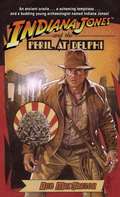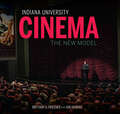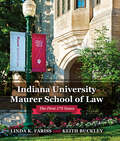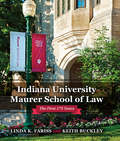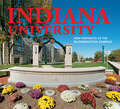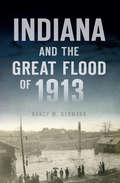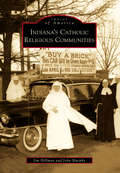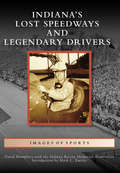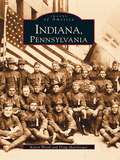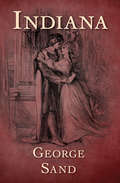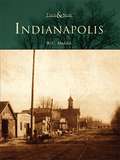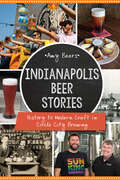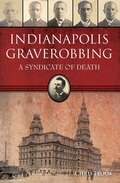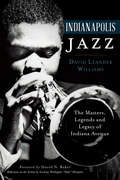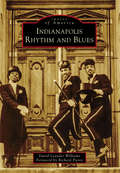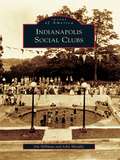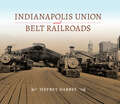- Table View
- List View
Indiana Jones and the Dance of the Giants
by Rob MacgregorIndiana Jones has landed his first teaching post, in the archaeology department at London University. His brightest--and prettiest--student is a twenty-year-old Scottish girl, Deirdre Campbell, who claims she's uncovered a golden scroll, proof of the true existence of Merlin, sorcerer of myth and legend. Indy's intrigued by the thesis ... and by Deirdre. So, too, is member of Parliament Adrian Powell. He's seeking to resurrect the ancient order of the Druids, whose secrets of power could pave his way to world conquest. But first he needs the scroll ... and he's willing to kill to get it. Where there's magic, mystery, and murder, Indy goes to the head of the class. Dropping his books and picking up his bullwhip, he joins Deirdre on an action-packed chase across Britain, from the peril-filled caves of Scotland to the savage dance of the giants at Stonehenge--where Merlin's secret will finally be revealed. But not before Indy gets a lesson in love from Deirdre ... and a lesson in hate from a maniac who means to rule the world.
Indiana Jones and the Peril At Delphi (Indiana Jones No. #1)
by Rob MacgregorINTO THE ABYSS OF THE SERPENT For sixteen centuries the Order of Pythia has awaited the reappearance of the ancient oracle of sacred knowledge at Delphi. An earthquake, rending the earth beneath the ruins, has now heralded her return. Dorian Belecamus, a beautiful and bewitching archaeology professor, sees an opportunity to do more than dig into the past: this is her chance to seize control of her country's future-by becoming the Oracle of Delphi! And she's found just the man to help her consummate her scheme. He's brash, he's reckless, and he's fallen under her spell. His name: Indiana Jones. Their adventure spans the globe from Chicago to Paris to Greece, where, bullwhip in hand, Indy descends into the bottomless pit of the serpent god and finds a sacred stone that holds the key to the oracle's prophecies. But Dorian has designed an even more sinister fate for young Indy: she means to make him her lover, her priest, and her pawn in a plot to kill the king. Will Indy find the source of Pythia's powers, or will he find himself sacrificed at Dorian's altar, a victim of her deadly ambition and desire?
Indiana Originals: Hoosier Heroes & Heroines
by Ray E. BoomhowerHoosier history overflows with bold visionaries, noble heroes and lovable rogues. May Wright Sewall struggled to uplift womankind and unflinchingly called for peace in a world sleepwalking toward conflict. In the guise of Abe Martin, Kin Hubbard graced the Indianapolis News's back page for twenty-six years with folksy humor. Combat photographer John A. Bushemi bravely faced the terrors of war and perished capturing its violence. Audacious automotive pioneer Carl G. Fisher went to any length to promote himself, even flying a car via a hot-air balloon. Drawing on more than thirty years of experience, author Ray E. Boomhower, the dean of Hoosier biographers, brings together forty of the most notable figures from the nineteenth state.
Indiana Timelinks: People, Places and Culture in Europe and the Americas [Grade 6]
by Dinah Zike James A. Banks Kevin P. Colleary Linda Greenow Walter C. Parker Emily M. SchellNIMAC-sourced textbook
Indiana University Basketball Encyclopedia: 2nd Edition
by Dick Van Arsdale Terry HutchensThe tradition of college basketball excellence that reigns at Indiana University can only be matched by a handful of other elite programs, while the fierce devotion of IU basketball fans has been selling out arenas and inspiring generation after generation of Hoosier fans for over a century. This newly revised edition of the captures the glory, the tradition, and the championships, from the team’s inaugural games in the winter of 1901 all the way through the 2016–17 season. The most comprehensive book ever written about IU basketball, this encyclopedia covers every season and every game the Hoosiers have played throughout their illustrious history, including all of the program’s Big Ten Conference championships and NCAA championships. Fans will relive the most exhilarating victories and the most heart-wrenching defeats. Included within are profiles of legendary Hoosiers stars, from Don Schlundt and the Van Arsdale twins all the way through Calbert Cheaney and Damon Bailey. The rivalries, excitement, and history of the Hoosiers are captured here with vivid detail and unparalleled statistical accuracy. Indiana University Basketball Encyclopedia is a must-have for the library of every devoted IU basketball fan and a fitting guide to one of the most storied traditions in all of college basketball.
Indiana University Bloomington: America's Legacy Campus (Well House Books)
by J. Terry Clapacs Susan Moke Dina Kellams Carrie SchwierAmid the forested hills of southern Indiana stands one of America's most beautiful college campuses. Indiana University Bloomington: America's Legacy Campus, the new edition, returns the reader to this architectural gem and cultural touchstone. Revised and updated to include new buildings and features of campus life, it is a must have for any Hoosier. The IU Bloomington campus, rich in architectural tradition, harmonious in building scale and materials, and surrounded by natural beauty, stands today as a testimony to careful campus planning and committed stewardship. Planning principles adopted in the very early stages of campus development have been protected, enhanced, and faithfully preserved, resulting in an institution that can truly be called America's Legacy Campus. Lavishly illustrated and brimming with fascinating details, this book tells the story of Indiana University—a tale not only of buildings, architecture, and growth, but of the talented, dedicated people who brought the buildings to life. Completely updated with new buildings and an epilogue, and now even more lavishly illustrated, this new edition is a lasting tribute to the treasure that is Indiana University Bloomington.
Indiana University Cinema: The New Model (Well House Books)
by Brittany D. Friesner Jon VickersIn its first ten years, a small Midwestern cinema has attracted some of the most intriguing and groundbreaking filmmakers from around the world, screened the best in arthouse and repertory films, and presented innovative and unique cinematic experiences.Indiana University Cinema tells the story of how the cinema on the campus of Indiana University Bloomington grew into a vibrant, diverse, and thoughtfully curated cinematheque. Detailing its creation of a transformative cinematic experience throughout its inaugural decade, the IU Cinema has arguably become one of the best venues for watching movies in the country. Featuring 17 exclusive interviews with filmmakers and actors, as well as an afterword from Jonathan Banks (Breaking Bad and Better Call Saul), Indiana University Cinema, is a lavishly illustrated book that is sure to please everyone from the casual moviegoer to the most passionate cinephile.
Indiana University Maurer School of Law: The First 175 Years (Well House Bks.)
by Keith Buckley Linda K. FarissA history of one of America’s oldest law schools, with photos and illustrations included.Throughout its 175-year history, the Indiana University Maurer School of Law has grown, diversified, and flourished to become of a nationally recognized law school. With strong and dedicated leadership, the school has emerged into the twenty-first century stronger than ever and has partnerships with leading institutions around the world, and an alumni base that spans the globe. Preparing students for the practice of law, promoting the best interests of society, and taking a leadership role in providing solutions to the most pressing problems of society are among the many achievements of the school and its faculty.Filled with historical photographs and engaging sidebars, this book tells the story of the individuals who built, sustained, and strengthened the Indiana University Maurer School of Law.
Indiana University Maurer School of Law: The First 175 Years (Well House Books)
by Keith Buckley Linda K. FarissThroughout its 175-year history, the Indiana University Maurer School of Law has grown, diversified, and flourished to become of a nationally recognized law school. With strong and dedicated leadership, the school has emerged into the 21st century stronger than ever and has partnerships among with leading institutions in the world, and an alumni base that spans the globe. Preparing student for the practice of law, promoting the best interests of society, and taking a leadership role in providing solutions to the most pressing problems of society, are among the many achievements of the school and its faculty. Filled with historical photographs and engaging sidebars, this book tells the story of the individuals who built, sustained, and strengthened the Indiana University Maurer School of Law.
Indiana University and the World: A Celebration of Collaboration, 1890–2018
by Patrick O'Meara Leah K. PeckThe story of a Midwestern university’s extensive engagement with nations and people around the globe, in words and pictures.Indiana University’s administration, faculty, and staff believe that an international reach is a central part of the teaching and research identity of a great university. From “summer tramps” led by faculty in the later 1800s, to providing support to a struggling German higher education system devastated by World War II, to partnering with Kenyan medical institutions and collaborating with Ukrainian parliamentarians, IU has participated in a diverse range of international opportunities.What connects these seemingly disparate efforts is their reciprocal nature. IU’s international activities have benefited countless individuals while also providing opportunities for the intellectual development of faculty and students. This commitment to international engagement continues into Indiana University’s third century, with the launch of Gateway offices in economically and culturally dynamic parts of the world such as China, India, Germany, and Mexico. This book takes a journey around the world with Indiana University, from Pakistan to Poland to Palestine, and shares stories of lives changed.
Indiana University and the World: A Celebration of Collaboration, 1890–2018 (Well House Bks.)
by Patrick O'Meara Leah K. PeckThe story of a Midwestern university’s extensive engagement with nations and people around the globe, in words and pictures.Indiana University’s administration, faculty, and staff believe that an international reach is a central part of the teaching and research identity of a great university. From “summer tramps” led by faculty in the later 1800s, to providing support to a struggling German higher education system devastated by World War II, to partnering with Kenyan medical institutions and collaborating with Ukrainian parliamentarians, IU has participated in a diverse range of international opportunities.What connects these seemingly disparate efforts is their reciprocal nature. IU’s international activities have benefited countless individuals while also providing opportunities for the intellectual development of faculty and students. This commitment to international engagement continues into Indiana University’s third century, with the launch of Gateway offices in economically and culturally dynamic parts of the world such as China, India, Germany, and Mexico. This book takes a journey around the world with Indiana University, from Pakistan to Poland to Palestine, and shares stories of lives changed.
Indiana University: New Portraits of the Bloomington Campus
by Kendall ReevesSet in the rolling hills of southern Indiana, Indiana University Bloomington is widely acknowledged to be one of the most picturesque college campuses in the United States Indiana University: New Portraits of the Bloomington Campus offers Hoosiers the chance to discover or revisit the campus for themselves and appreciate stunning new buildings and improvements in landscaping and facilities. During its two-hundred-year history, the Bloomington campus has grown out from its original core while maintaining its focus on its architectural atheistic. Indiana University Bloomington now occupies nearly 2,000 acres, and the beauty and harmony of its limestone buildings set against breathtaking natural scenery make the campus a treasure that all Hoosiers enjoy.Indiana University: New Portraits of the Bloomington Campus offers Hoosiers the chance to travel back home, relive past friendships, scholarly achievements, Little Fives, and Hoosier victories, and wander again, if just for a moment, through Dunn's Woods, the Cox Arboretum, and the iconic Sample Gates.
Indiana and the Great Flood of 1913 (Disaster)
by Nancy M. GermanoIndiana suffered enormous losses in the Great Flood of 1913, yet this disaster is largely forgotten. The combined tornado and flood barreled through Terre Haute, killing more than twenty. In Peru, 114 miles away, the circus lost most of its animals in the storm. At the southwestern corner of the state, a "sea of water," as local papers put it, washed over Evansville, turning streets into canals. In the capital, levee failures left hundreds homeless and vulnerable to disease and famine. Pulling from archival photographs, newspapers and local accounts, Dr. Nancy M. Germano shares stories from across the state to reveal how Indiana's history of settlement and development contributed to one of the state's worst disasters.
Indiana's Catholic Religious Communities
by John Murphy Jim HillmanWith expanding Irish, Swiss, French, and German immigrant populations, the state of Indiana evolved from individual explorers, trappers, hunters, and traders into family-focused communities of farmers and craftsmen. Emerging from the former Indiana Territory, the state's early population was in need of education, health care, and social services to assist young families, the poor, the infirm, and the elderly. These needs were frequently met by Catholic religious orders, including the Benedictines, Sisters of Providence, Franciscans, Daughters of Charity, and other established organizations of dedicated religious men and women.
Indiana's Lost Speedways and Legendary Drivers (Images of Sports)
by David HumphreyFrom the Indianapolis 500 Motor Speedway to the dirt oval tracks in small Indiana towns, thousands of Hoosiers frequent the raceway of their choice each year. Today, there are an estimated 40 asphalt, clay, and dirt-covered oval tracks in Indiana where race fans cheer local drivers, often navigating jalopies pieced together from junkyard parts, to victory lane. Though many racetracks remain in operation throughout the state, dozens have fallen to the wayside over the past 100 years. Forever in remembrance are the famous and not so famous Indiana-born drivers who thrilled fans at those now defunct tracks. Evansville native Charlie Wiggins won the Gold and Glory Sweepstakes four times. Bob Kinser from Bloomington raced over 40 years and is an inductee of the National Sprint Car Hall of Fame, and Tom Cherry of Muncie won the Little 500 four times.
Indiana, Pennsylvania
by Karen Wood Doug MacgregorNestled in the hills of scenic western Pennsylvania, the borough of Indiana is a center of learning and the seat of county government. Incorporated in 1816, the borough lies in the heart of the state's bituminous coal region. Indiana has been home to a wide variety of industries and businesses, from breweries and lumber companies to higher education and Christmas tree farms. Among thousands of successful families and individuals, Indiana is famous as the home of actor Jimmy Stewart, Gov. John S. Fishe, and author Ed Abbey.Indiana, Pennsylvania is a compilation of stunning photographs that reveal a historical community. Included in this valuable history are the secret connections to the Underground Railroad, the arrival of electricity and telephones, the first automobiles, and the last Civil War veteran. Indiana, Pennsylvania also features many parts of the borough that have vanished, such as Indiana's early buildings and most of the old downtown hotels.
Indiana: A Love Story (Erotic Classics )
by George SandA noblewoman travels from colonial Africa to revolutionary France in search of love in this nineteenth-century romantic classic. On the Île Bourbon off the coast of Madagascar, Indiana is miserable in her marriage to the cold Colonel Delmare. Although she has a friendly companion in the ever-present Englishman Sir Ralph, she yearns to feel passion and desire. When she catches the interest of the handsome young Raymon de Ramiere, Indiana is willing to take any risk, including running away to France as the July Revolution rages in Paris. But after she falls ill, she will begin a transformation that could bring about her happiness—or her downfall. The first novel Amantine Aurore Dupin published under the pseudonym George Sand, Indiana was an auspicious debut from one of the most fascinating and daring women of the early nineteenth century, a rebellious artist who defied societal expectations and went on to become one of the major names in French literature.
Indianapolis
by W. C. MaddenInaugurated as the state capital in 1825, Indianapolis was patterned after the nation's capital and laid out on a mile-square grid with Monument Circle at its center. As the city grew and experienced the tumult of the Civil War, legislators decided to erect a monument to the war's fallen servicemen. In 1902, one of the world's most outstanding memorials was completed-the Soldiers and Sailors Monument. Surrounding Monument Circle, "The Circle City" gets its nickname from the prominence and historical significance of the central city structure. Throughout the years, Indianapolis has maintained its commitment to honoring the achievements of Hoosiers. This dedication to Indiana has given the capital its own rich history, told not only through monuments and memorials, but also through the architecture, parks, businesses, and people that make up the heart of Indianapolis. This new book documents the heroes and history of the city, using an impressive collection of vintage photographs from the late 1800s through the early 1900s juxtaposed against present-day images.
Indianapolis Beer Stories: History to Modern Craft in Circle City Brewing (American Palate)
by Amy BeersIndianapolis Beer Stories is a time capsule of tales from the city's early taverns, to a pre-Prohibition golden era, to today's modern craft beer scene.Meet the ghosts of Indy's brewing past. Discover the very beginning of beer in Indiana's new capital and the pioneers who carved a path for a future industry. Uncover the legacy of a bygone brewing giant. Learn how one spontaneous decision to cross the treacherous Rocky Mountains led to a booming craft beer scene in Indiana.Indiana native Amy Beers, a Certified Cicerone® and owner/operator of Drinking with Beers, leads a heady tour of yesterday and today in Circle City brewing.
Indianapolis Graverobbing: A Syndicate of Death (True Crime)
by Chris FlookSurveying the sensational newspaper accounts as events unfolded, author and historian Chris Flook recounts this grisly tale of political intrigue and conspiracy. In the fall of 1902, Indianapolis police uncovered a prolific graverobbing ring operating across the city. At the time, cemeteries across central Indiana were relieved of their dead by ghouls, as they were called, seeking fresh corpses desperately needed by the city's medical colleges. The ring was also accused of multiple murders. In Hamilton County, a former Confederate soldier named Wade West delivered stolen corpses by floating them down the White River. His counterpart in Indianapolis, Rufus Cantrell, an itinerant preacher and full-time graverobber known as the "King of the Ghouls," ransacked Indy's cemeteries for years before being caught.
Indianapolis Jazz: The Masters, Legends and Legacy of Indiana Avenue (Music Ser.)
by David N. Baker David Leander WilliamsGet into the music with David Leander Williams as he charts the rise and fall of Indiana Avenue, the Majestic Entertainment Boulevard of Indianapolis, which produced some of the nation's most influential jazz artists. The performance venues that once lined the vibrant thoroughfare were an important stop on the Chitlin' Circuit and provided platforms for greats like Freddie Hubbard and Jimmy Coe. Through this biography of the bustling street, meet scores of the other musicians who came to prominence in the avenue's heyday, including trombonist J.J. Johnson and guitarist Wes Montgomery, as well as songwriters like Noble Sissle and Leroy Carr.
Indianapolis Rhythm and Blues (Images of America)
by David Leander WilliamsIndiana Avenue was traditionally the host to some of America's premier, world-renown entertainment icons in various genres. Along this winding, brightly lit thoroughfare were nightclubs, lounges, supper clubs, taverns, juke joints, and holes-in-the-wall that celebrated the best of the best in entertainment that America had to offer, from the 1920s on into the 1970s. On the bandstand at Denver Ferguson's Sunset Terrace Ballroom, the elegantly attired crooner Nat King Cole, in a sparkling blue silk suit, delivered his signature song "Mona Lisa." Nearby, B.B. King sang his 1973 down-home blues classic "To Know You is to Love You." At Tuffy Mitchell's Pink Poodle nightclub, "Moms" Mabley made the audience roar with laughter during her sidesplitting comedy routine. Indiana Avenue truly was the place to be for the best in entertainment.
Indianapolis Social Clubs (Images of America)
by John Murphy Jim HillmanMore than banquet halls, golf courses, and swimming pools, social clubs were a haven for businessmen, politicians, and community leaders, offering respite from public scrutiny. Defining Indianapolis, the clubs were stoic agents of power and segregation, providing clear historical snapshots of Hoosier pomp and circumstance. The clubs did more than produce Olympic swimmers, world-class golfers, and tennis professionals; they were Indianapolis's multigenerational playgrounds. There were the politics and business dealings at the Columbia Club and the Indianapolis Athletic Club, the golfing, tennis, and formality of Woodstock, Meridian Hills, and other country clubs, and the family fun in the sun at Riviera, Devon, and Olympia. These organizations offered more than magical summers with family and friends; they were the places to be seen.
Indianapolis Union and Belt Railroads (Railroads Past and Present)
by Jeffrey DarbeeA comprehensive history of how railroads aided in the growth of Indiana and its capital city, featuring maps and illustrations.In an era dominated by huge railroad corporations, Indianapolis Union and Belt Railroads reveals the important role two small railroad companies had on development and progress in the Hoosier State. After Indianapolis was founded in 1821, early settlers struggled to move people and goods to and from the city, with no water transport nearby and inadequate road systems around the state. But in 1847, the Madison & Indianapolis Railroad connected the new capital city to the Ohio River and kicked off a railroad and transportation boom. Over the next seven decades, the Indiana railroad map expanded in all directions, and Indianapolis became a rail transport hub, dubbing itself the “Railroad City.” Though the Pennsylvania and the New York Central Railroads traditionally dominated the Midwest and Northeast and operated the majority of rail routes radiating from Indianapolis, these companies could not have succeeded without the two small railroads that connected them.In the downtown area, the Indianapolis Union Railway was less than two miles long, and out at the edge of town the Belt Railroad was only a little over fourteen miles. Though small in size, the Union and the Belt had an outsized impact, both on the city’s rail network and on the city itself. It played an important role both in maximizing the efficiency and value of the city’s railroad freight and passenger services and in helping to shape the urban form of Indianapolis in ways that remain visible today.“A good history book explains why things are the way they are. This is a great history book, neatly telling the value of railroads in the development of the United States as well as in Indianapolis. Footnotes and bibliography combined with maps and ephemera and photos of everything from track construction to buildings to locomotives make it of interest to architects and engineers as well as rail fans and Hoosier history buffs. It’s a super tour guide, too.” —Cynthia L. Ogorek, coauthor of The Chicago & Western Indiana Railroad“An interesting history not only of these two railroads but how they ultimately served as a model for the many other belt railroads . . . [The book discusses] how and why railroads transformed Indianapolis into a major city; in fact, the largest U.S. city not on navigable water.” —Tom Hoback, Owner, Indiana Rail Road Company
Indianapolis in Vintage Postcards (Postcard History)
by W. C. MaddenIn the late 1800s, postcards of Indianapolis began appearing in mailboxes throughout the country. Since that time, the many prominent monuments, buildings, and parks of the Hoosier capital have been featured on countless cards.Using an impressive collection of these images, author W.C. Madden takes the reader on an historic journey through Indianapolis from 1890 to 1950, providing a visual history of the development of the city. Indianapolis experienced great growth during the first half of the 20th century, which gave rise to innovative art and architectural structures, many that serve as the subject of postcards featured here. The Soldiers and Sailors Monument, the Indiana World War Memorial, the Indianapolis Motor Speedway, Union Station, and Claypool Hotel, to name a few, are all highlighted.

